The Human Side of AI: How Chatbots Are Reshaping Customer Relationships
Table of Contents
The Rise of the New Era, Where Chatbots are No Longer Optional
What does your customer have to do when they have an urgent matter to be resolved in the middle of the night?. A couple of years ago, they had to wait until dawn with their growing impatience. Now, all they need to do is get an instant answer that is helpful and eminently gives a human feeling. This is not a fictional scenario; this is the actual reality of AI-powered chatbots with a huge impact on businesses.
“Before vs After” customer service
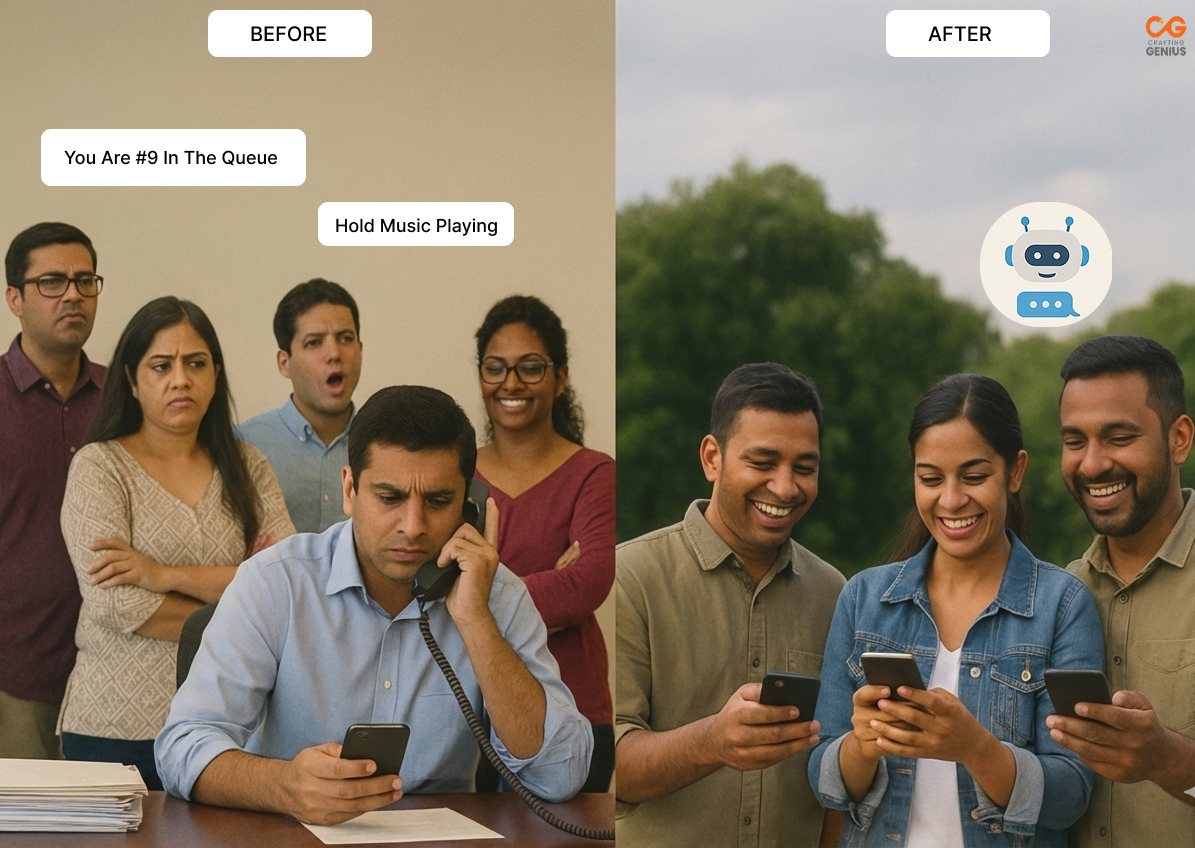
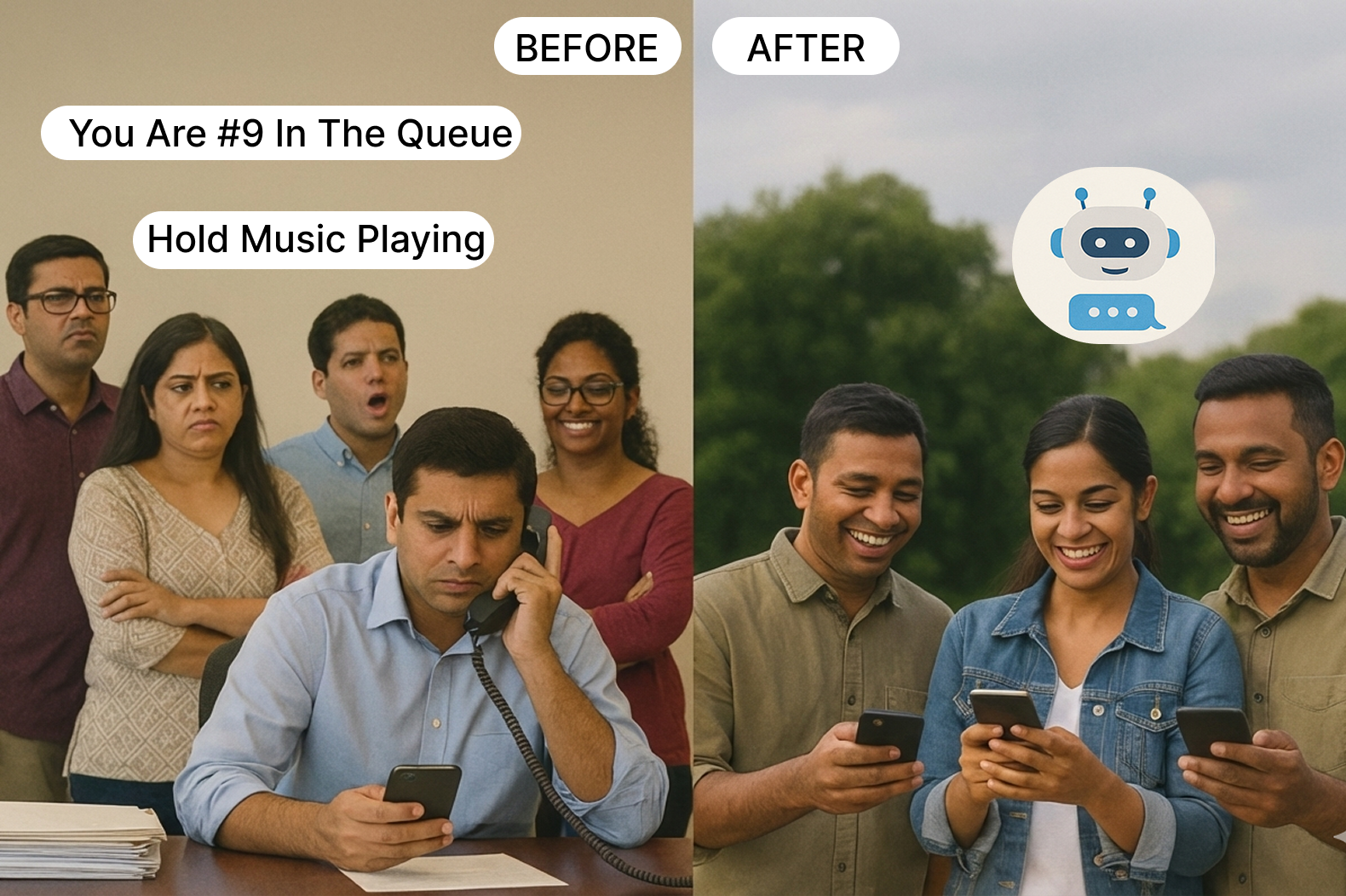
www.craftinggenius.in
Numbers Are Proving the Case of Explosive Growth
Global Markets Explosion
Market Growth: As per Global View Research, the market will grow at a CAGR of 23.3% between 2025 and 2030. And the chatbot market of North America is at the top globally, by showing a share of 30.72% as stated in Exploding Topics.
Regional Adoption: Then comes Asia Pacific with 28.45% and Europe at the 3rd place by having 25.34%, as represented in Exploding Topics Statistics Blog.
Industry Leaders: Industry-wise the technology industry stands first as the most satisfied one with 73%, then comes retail with 67%, and in the third place is the manufacturing industry with 57%, according to Saufter.io.
Query Resolution: As per Haptik, most of the day-to-day queries, which may be personalized queries or FAQs, are answered by AI chatbots by constituting 80%.
Now, what makes those numbers immensely impressive is that they represent so many actual conversations, resolved issues, and satisfied customers. There is a real person behind those data points and statistics who could reach out for help through automated customer interaction at a time they really needed it.
Regional Adoption Rates:

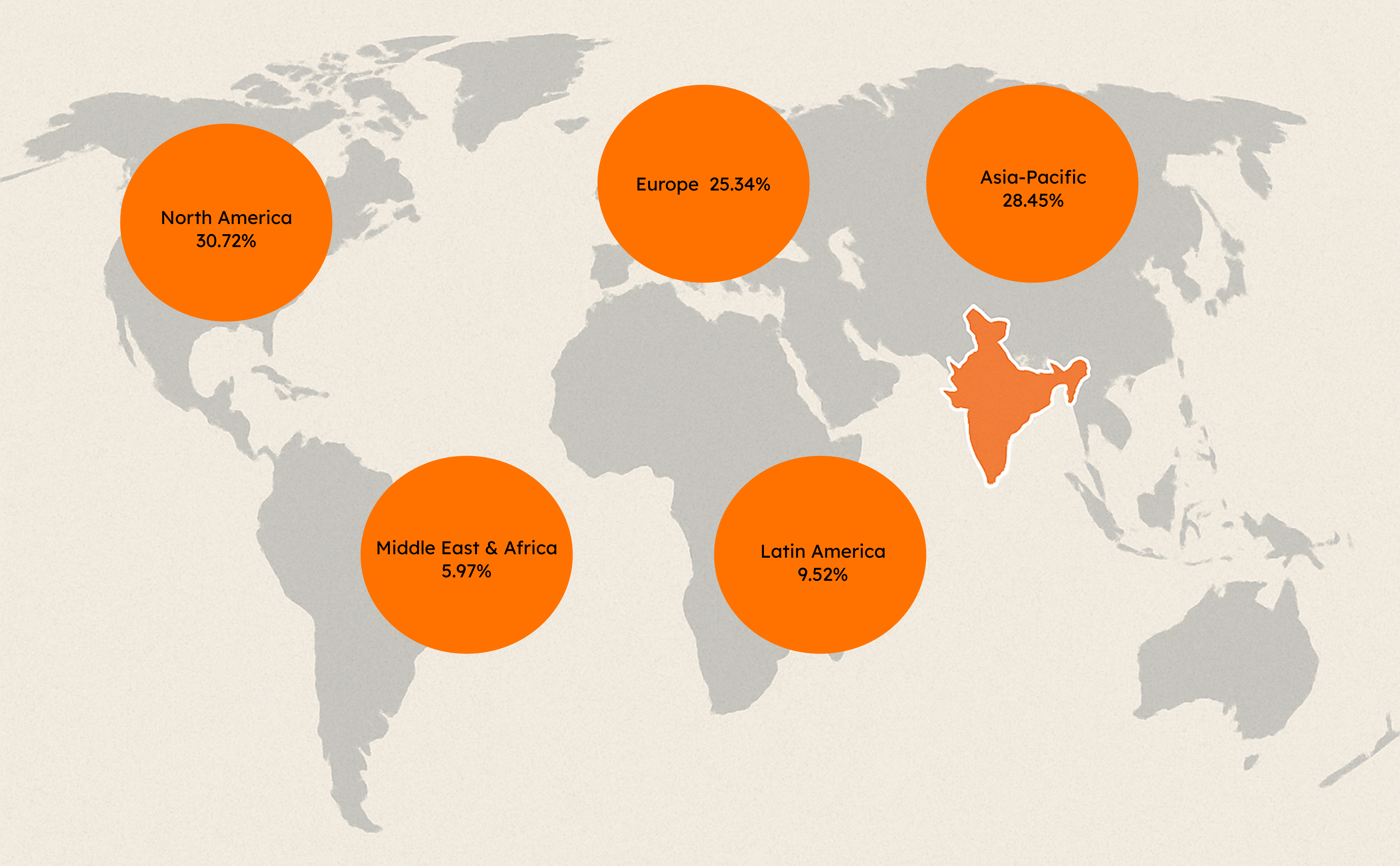
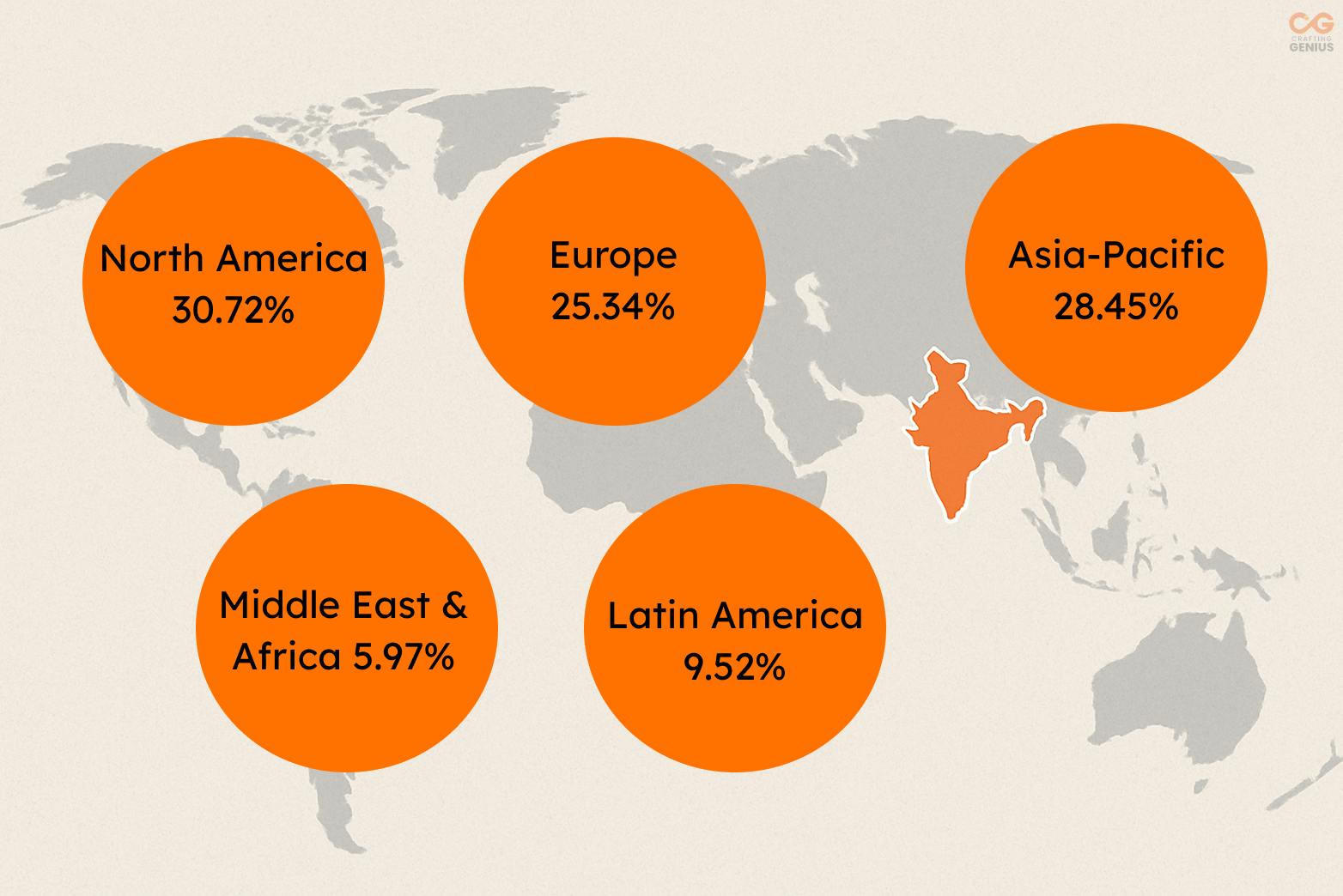
www.craftinggenius.in
Source: https://explodingtopics.com/blog/chatbot-statistics
Industry-wise Adoption Percentages

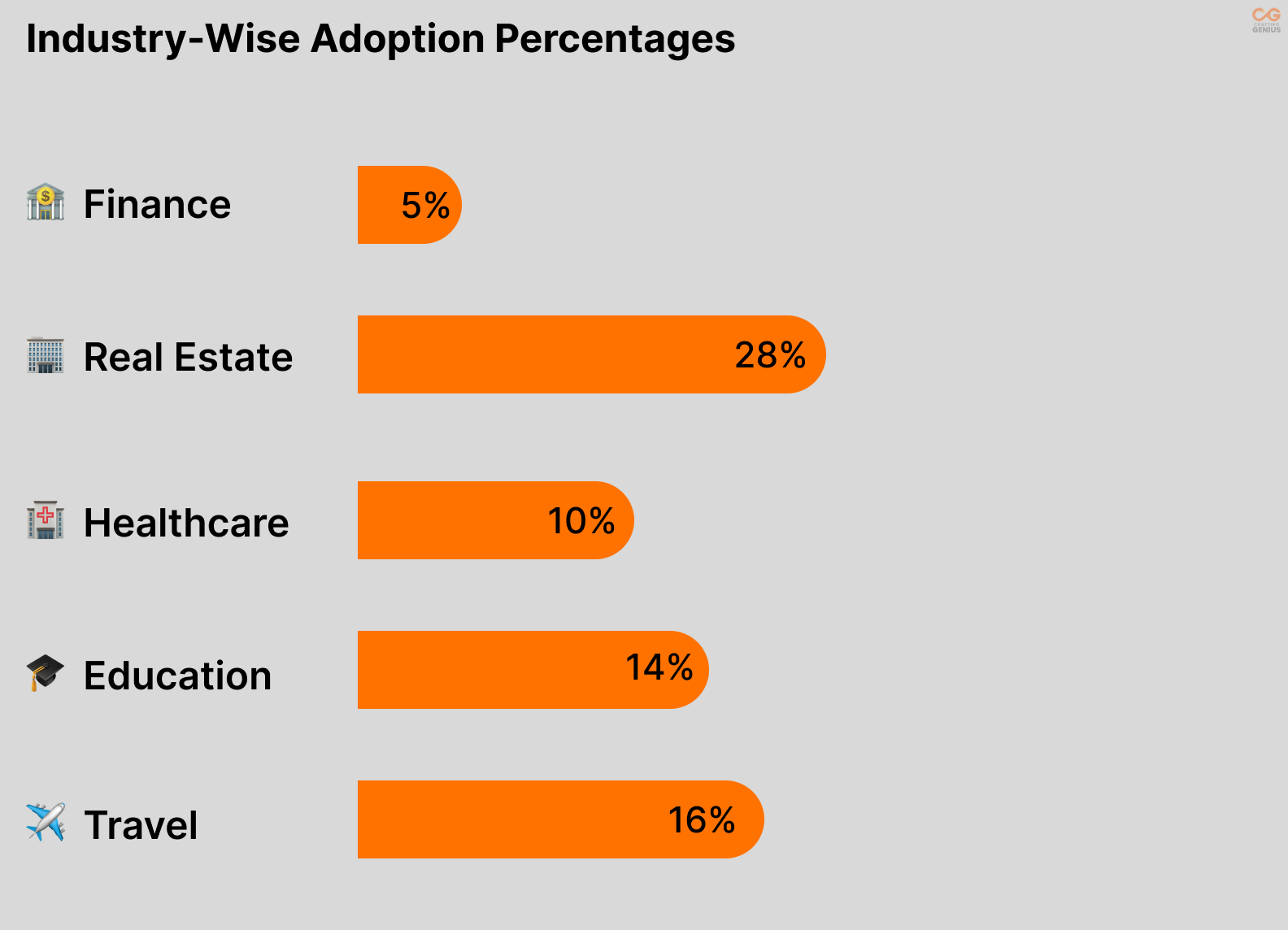
www.craftinggenius.in
India’s Digital Leap Forward
The story becomes even more powerful when it comes to Indian growth statistics in the field of AI chatbots. AI in the Customer support hit $243.3 million in 2024, and it is forecasted to reach $1,465.3 million by 2033, as per the projection of IMARC Group. It is beyond technology adoption; it is about making customer service available to the masses.
Important market statistics of AI chatbots
Growth Rate: According to IMARC Group projection, the CAGR of 20.43% is expected growth rate in the market of Indian chatbots from the year 2025 to 2033.
Digital Population: In India, the internet users are expected to reach 900 million by 2025 due to the powerful role of AI, as reported in DD News.
Language Diversity: Most of the users, nearly 98% consumed the content in regional languages like Telugu, Tamil, etc, and 57% of users still choose to consume in Indian languages, indicating the scope for local language in all platforms, according to the report of DD News.
Top Applications: Chatbots for the Service sector stand at the top, for social media being in second place, and payments and order processing in third place, as shown by IMARC.
Indian Success Stories: Real Companies, Real Results
Case Study 1: HDFC Bank – Electronic Virtual Assistant (EVA) Chatbot
The results they achieved through this innovation:
- It resolved more than 2.7 million customer queries within just the time period of six months.
- It had a conversation with more than 5,30,000 different users with owning 1.2 million interactions with them.
- It has an accuracy of 85% and is on time for 99.9% of the time to resolve customer queries, as reported in ET CIO.
Ola launched an AI-powered chatbot, i.e., Kutrim, that can support 10 indian languages such as English, Hindi, Tamil, Bengali, Marathi, Kannada, and Gujarati, representing the scope and need of multilingual and regional languages among indian users by removing the language barrier.
The Impact It Left On The Company
- It handles the customer queries across all channels like web, mobile, and voice channels.
- It reduced the cost of human agents along with a significant improvement in service efficiency.
- It also provides information about suspicious or spam activities in real time.
Global Success Stories: Learning From The Leaders
Case Study 1: Sephora – Beauty Personalization at Scale
The results it achieved:
- It achieved an increase in its in-store booking services by 11%.
- It earned revenue of more than $10 billion annually, as per Go Beyond AI.
Case Study 2: Erica Chatbot of Bank of America (BofA)
BofA’s Erica chatbot gives 24/7 customer services to customers by providing financial guidance, assistance in banking activities like paying bills, checking balances, and active alerts related to spam, due dates, etc.
The results achieved by Erica: As per the report of Bank of America
- It achieved more than 2.5 billion interactions with customers.
- Nearly 20 million customers are using the Erica chatbot and have seen year-over-year growth of 7%.
Beyond 24/7: The True Value of Always-On Support
Efficient Usage: Nearly 29% of interactions with customers are happening after the working hours of the company.
Important market statistics of AI chatbots
Satisfaction of Customers: 64% of customers reported that the best feature of chatbots is 24*7 availability, as it solves their queries anytime, as stated by Master Of Code.
Business Impact: Chatbots are significantly reducing the cost of customer service, i.e., 30% and they are 4 times more efficient than human agents.
Resolution Rates: As per Smythos, chatbots are handling nearly 80% of the basic and routine queries of the customers by reducing the major portion of human intervention.
The Real Impact of Chatbots on Customer Service
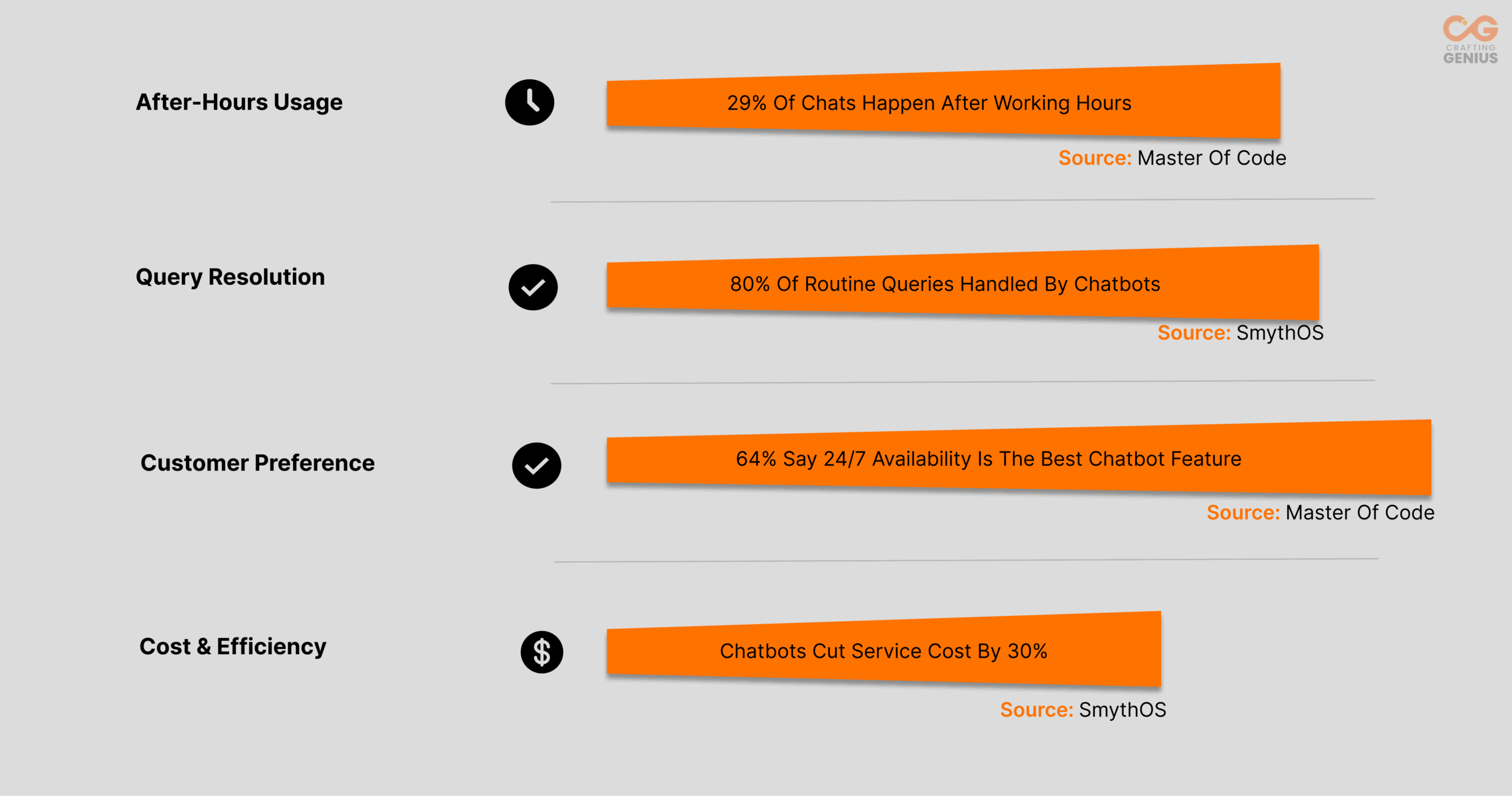
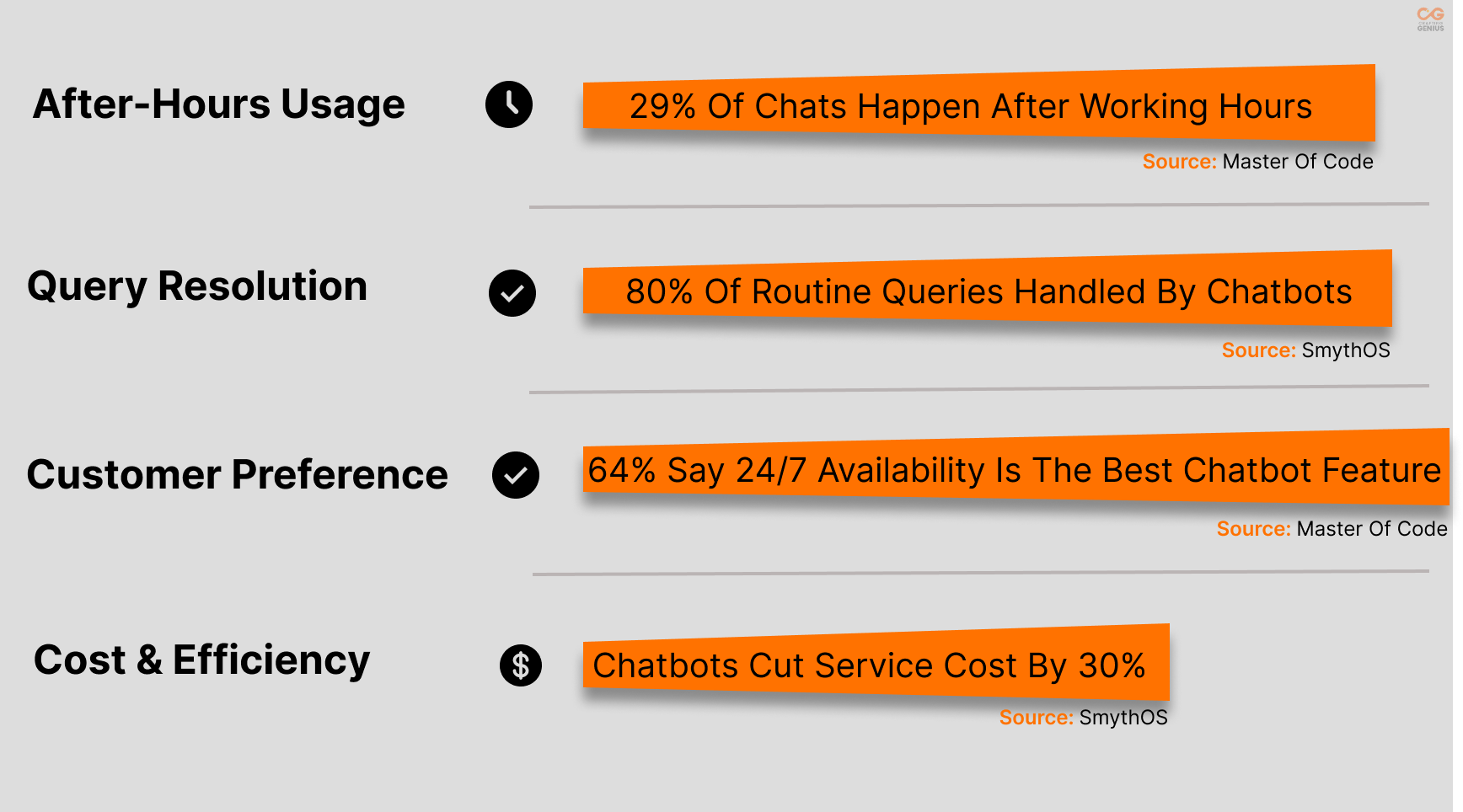
www.craftinggenius.in
The Revolution of Emotional Intelligence
This is where the real magic begins to unfold. The conversational AI is not just working on the customer requests to resolve their queries but it also understanding the emotions behind their queries. The research report by Zendesk said that 71% of the customers believe in the fact that AI is making the interactions of customers more empathetic.
More advanced capabilities of AI Technologies
Sentiment Analysis: By using advanced AI-enabled emotion detection technologies, businesses achieved a 30% increase in customer satisfaction and purchase rate, according to scanwatch.
Case Study 1: HDFC Bank – Electronic Virtual Assistant (EVA) Chatbot
Tone Adjustment: By observing the mood of the customers, chatbots change their tone and style of communication.
Escalation Intelligence: They automatically transfer to a human agent if they find the customer is frustrated.
Emotional Analytics: Chatbots detect the customer’s emotions and track them over the period of time.
The Emotional Intelligence Finds Its Expression In The Following:
Context-Aware Conversations
Personalization At Scale
With over 1.4 billion users interacting with AI chatbots worldwide, as per the research of VFS Global, the technology has learned to deliver highly personalised chatbot experience to customers to make sure they are getting in-person solutions. The report by Genesys said that CX customers did research to know that AI is essential to do their work, especially in the coming two to three years.
Great Natural Language Processing systems integrate not just the literal meaning of the customer’s words but the manner in which they are said, thus fostering truly empathetic interactions with customer engagement taken to great extent.
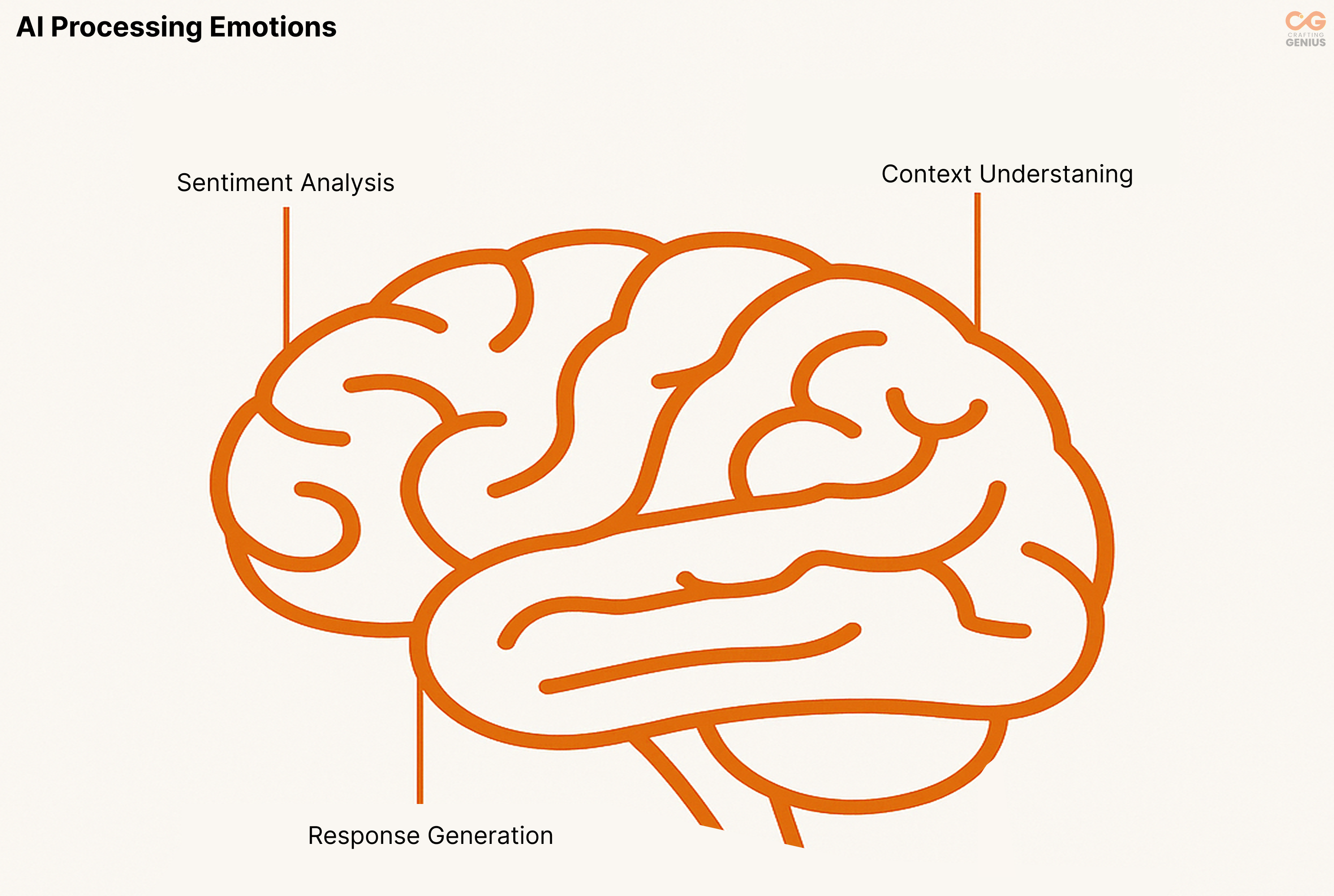
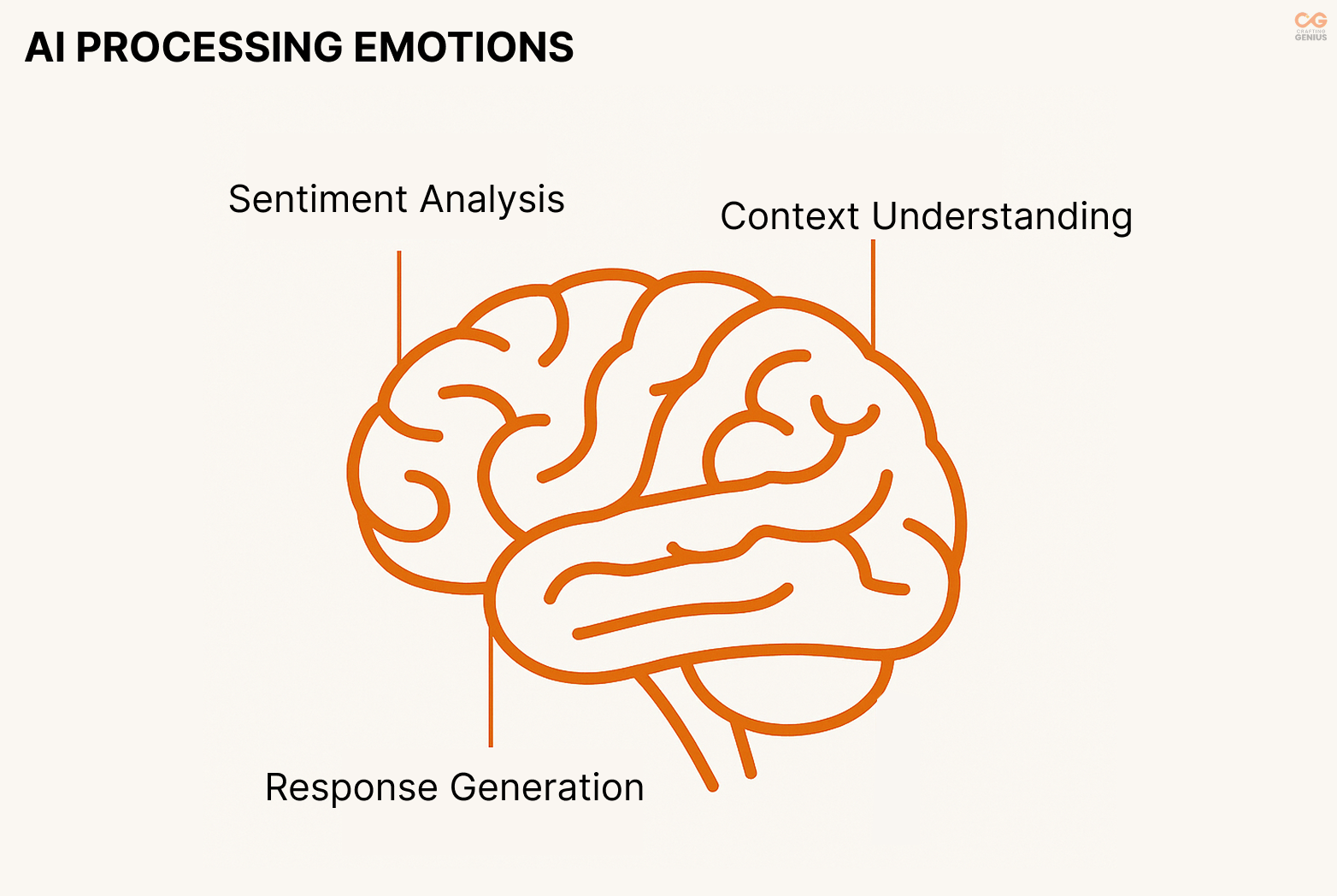
www.craftinggenius.in
Indian Innovation Spotlight:
Companies like Haptik and Yellow.ai are leading in the development of culturally rich and emotion-aware chatbots that understand the nuances of Indian customer communication styles while achieving greater satisfaction from their users when compared to generic solutions.
The Integration Challenge: Making Technology Invisible
The best implementation of chatbot integration is one that the customer barely notices: It simply works. This means integration should work seamlessly across all touchpoints, such as your website, mobile apps, social networks, voice assistants.
Success Metrics for Integration Efforts:
Platform Coverage: Top companies deploy the chatbots across 8+ channels at the same time, as per ProProfs.
Mobile Optimization: The Mobile segment is projected to achieve the growth of CAGR of 24.1% during the time period of 2022-2032, as reported in Kommunicate.
Data Consistency: Single customer view across all touchpoints
Modern companies create unified customer profiles that go across channels because of AI and CRM integration. When a customer enters the conversation on WhatsApp and proceeds to your website, the chatbot remembers everything. This convenience effectively saves the customer time and effort.
Indian companies have become innovators in deploying accent-neutral virtual assistants for businesses, which speak to international clients clearly while retaining local language capabilities for domestic customers.
Indian Multilingual Success Stories:
Bharti Airtel: It provides a spam detection facility that is based on AI for its customers in 10 different regional languages.
Flipkart: Flipkart provides the interface in 11 different regional languages, highlighting its optimisation for local markets as stated by ET Retail.
Case Study 1: HDFC Bank – Electronic Virtual Assistant (EVA) Chatbot
Paytm: It also optimised its interface with 10 regional languages to make the payments and shopping easy and comfortable for its customers, as reported by Business Standard.
This bilingual or multilingual approach is increasingly becoming a blueprint for global companies implementing multi-channel chatbot deployment.
The success of these integrations relies significantly on chatbot analytics that monitor the performance across all touchpoints, thus making sure there is a consistent AI customer experience irrespective of the media through which customers wish to communicate with your brand.
Wherever the Customer Goes, Data Follows
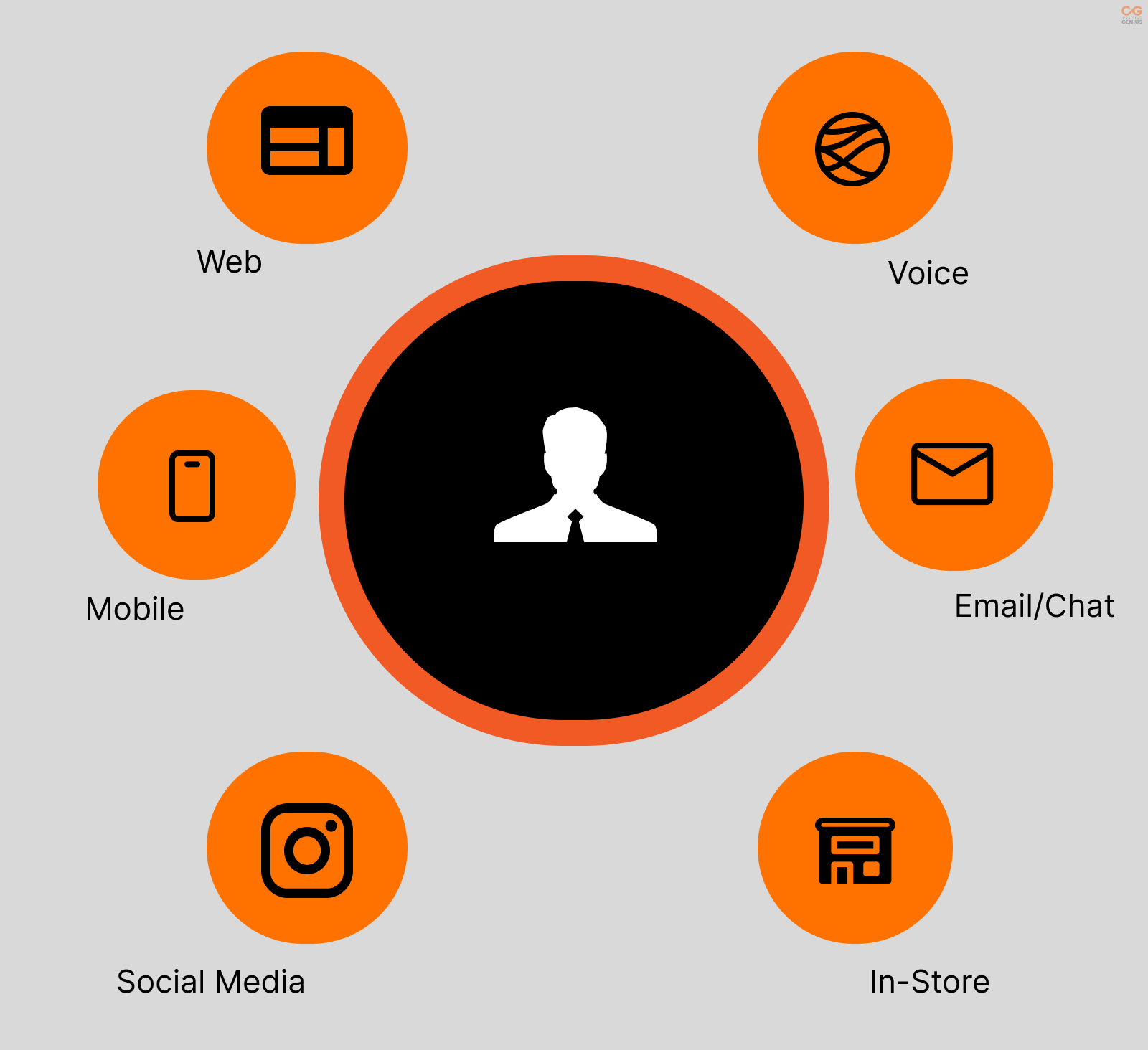
Real Business Impact: Beyond the Hype
Revenue Impact:
By providing personalised recommendations and following up smartly with the help of AI chatbots, companies are achieving a 20% hike in repeat purchases, according to CONVIN.
The chatbots are significantly improving the process of lead generation, resulting in a 50% reduction in unqualified leads, as per the SmythOS statistics report.
AI Chatbots in product recommendations are playing a major role by enhancing the cart value on average by 31%, encouraging nearly half of the customers to buy things that they didn’t plan to, as stated by the God of Prompt.
Chatbots are helping to resolve nearly 20-30% of customer queries, then making the purchasing process smoother, according to SmythOS.
Wherever the Customer Goes, Data Follows

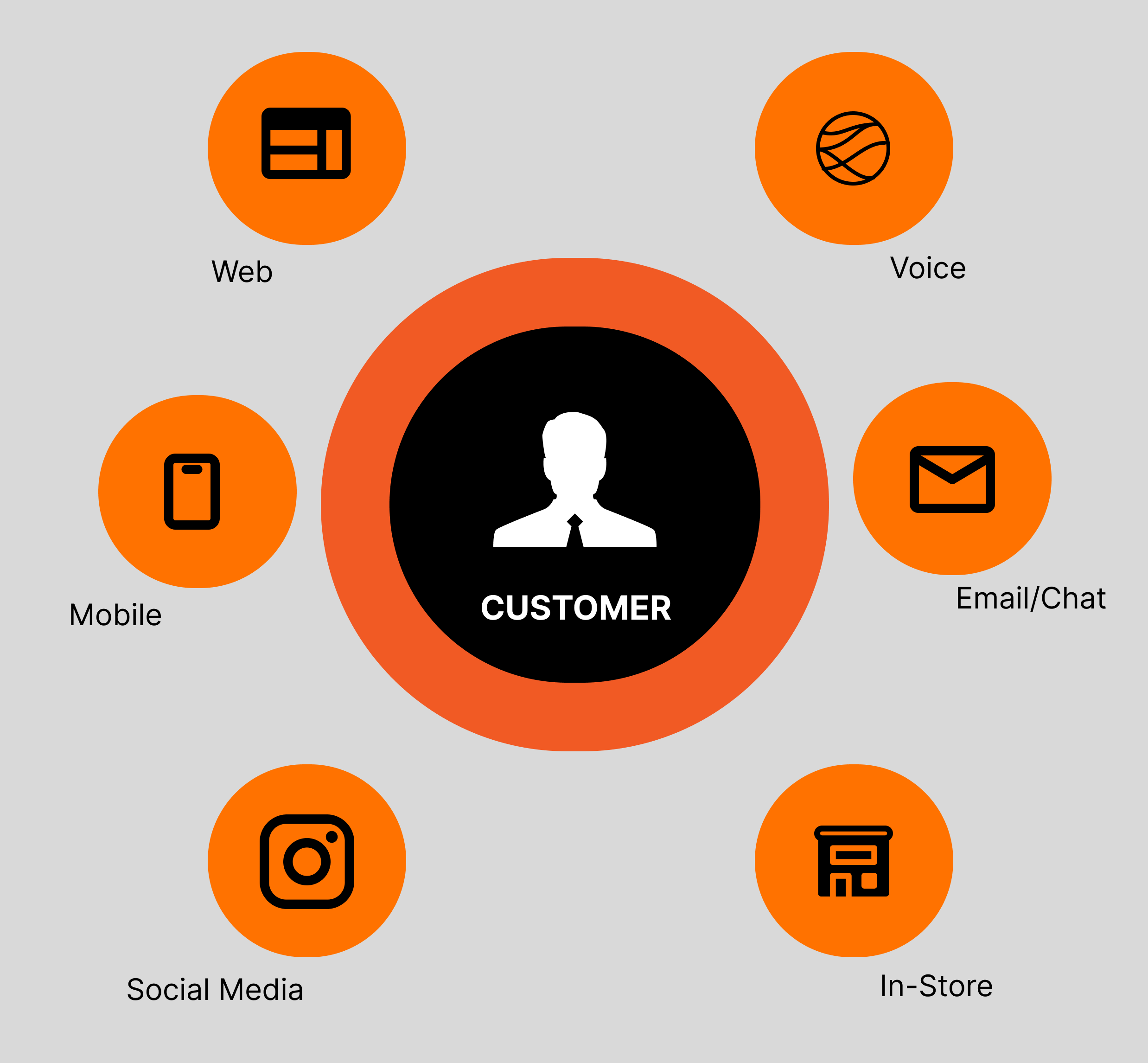
Operational Excellence:
AI-enabled assistants will give nearly 25% accuracy in solving basic queries by improving the tools, as mentioned in ClearTouch.
These chatbots will increase the productivity of agents by 40% by reducing their work burden from repetitive queries, as per the report of Sprinklr.
Compared to traditional customer support channels, AI chatbots are increasing customer satisfaction by nearly 87.58%, as stated by Sobot.
Indian ROI Spotlight: Measurable Success
Conversational AI’s powerful effects are leading to measurable results witnessed across big sectors in India, like banking and e-commerce. Such robotic automation foresees reducing operational costs on the one hand and underlining customer experience on the other hand, thus driving considerable nurturing points of differentiation. These success stories give examples of how Indian enterprises are turning technology investments into real business benefits.
Banking Sector:
ICICI Bank: In ICICI, the introduction of these chatbots reduced the response time to customers by up to 60% and accuracy also increased to 100%, as reported in Emerj.
SBI: 40% decrease in call center load with multilingual support. In SBI, the SIA chatbot handles nearly 25% of the day-to-day queries of the customers, according to Emerj.
E-commerce Giants:
Amazon India: 55% of customer queries resolved through automation. Through Amazon’s conversational AI, there is a significant reduction in the time taken to resolve the issues, which is nearly 30% by giving instant solutions, as per CONVIN AI.
BigBasket: It improved the uptime up to 99.9% by implementing an AI chatbot, as per a LinkedIn post.
All the successful businesses implemented these AI-driven customer insights to meet the customer’s needs and comfort. The companies are taking advantage of chatbot user engagement metrics to provide a strong AI customer experience by improving their strategies and systems.
Industry leaders still claim that AI work more efficiently than human agents at resolving issues and providing routine service to customers. For complex issues, however, customers want the intervention of human agents, highlighting the need of balance in customer support between AI and human agents.
Most of the business leaders, nearly 72% are said that their top goal is to add AI in customer service to fulfill the needs of digital customers, as per Zendesk. And the other report by Infosys BPM said that even though AI handles 95% of the customer service issues but the remaining 5% of human agents’ role is irreplaceable.
The best implementations adhere to the simplest notion: allow conversational AI to do what it can do better, like instant responses, data processing, and routine queries, then smoothly transition, a human agent for complex, emotional, or subtle situations. It is not a displacement; it is a determined collaboration to enhance customer engagement.
Such a balanced implementation offers that magic touch of personalization between chatbot experience and human interaction, leveraging the great efficiencies and real-time availability that only intelligent chatbots powered by AI can offer.
Emerging Trends: What Is Shaping the Future
Global Trends Reshaping Customer Service
1. Generative AI Integration
Content Creation: The salon now uses Chatbots to provide customized emails, offers, and recommendations to its customers.
Creative Problem-Solving: AI offers creative ways of tackling difficult customer issues.
Data Synthesis: Automatic interpretation of customer interaction data to generate insights.
2. Voice-First Experiences
Voice Purchases: In US, most of the customers nearly half of them are shopping by using voice search, according to MINDSTER.
Multilingual Voice: Resemble AI provides almost 120 languages to customers to break the language barriers.
Smart Speaker Integration: Nearly 60% of the customers are completing their purchases by using smart voice assistants, as stated by MINDSTER.
3. Predictive Customer Service
Proactive Support: AI foresees matters before being reported by the customer.
Behavioral Analytics: Detecting customer behaviors for retention campaigns that are at risk.
Personalized Interventions: Based on the predictive needs, it gives customized solutions.
Indian Market Innovations
1. Vernacular AI Revolution
Regional Languages: This supports 8 Indian languages other than English in its chatbots, voice commands, and translation, as mentioned in NetZeroIndia.
Cultural Context: AI comprehends local customs, festivals, and modes of communication.
Voice to Text: Converts spoken regional languages to text and vice versa.
2. Digital India Integration
Aadhaar Integration: By using API’s, this system is offering real-time verification of identity.
UPI Payments: UPI payments also integrate Aadhaar verification to check the authenticity of users by using OTP, e-KYC, etc.
Government Services: In public information and citizen services, chatbots are playing a significant role.
3. Rural Market Penetration
Low-Bandwidth Optimization: Even in low network areas, like on 2G/3G networks, the chatbots perform well.
Agriculture Support: We can also interact on topics like farming, weather forecasts, and market prices with AI chatbots to get accurate information instantly.
Healthcare Access: Even health consultations are happening through AI chatbots.
Let us be honest about the challenges. Most of the businesses have a tough time dealing with:
Integration Complexity: When systems, data formats, and even security concerns are making us worry, and can make us feel overwhelmed. So, how to solve it? Start small, use integration-friendly platforms, and plan well.
Global Integration Challenges:
Legacy Systems: According to DREAMIX, the study highlights that 65% of the companies are concerned about data privacy and still depend on legacy systems for crucial business functions.
Data Silos: 72% face challenges in unified customer data access. 72% of the companies are having problems with siloed customer data, as mentioned in the CEO Hangout.
India-Specific Challenges:
Language Diversity: There are 22 official languages and hundreds of vernaculars in India.
Device Fragmentation: Optimizing for low-end smartphones and feature phones
Payment Integration: Integrations with multiple payment gateways and digital wallets
Maintaining The Human Touch: The fear of sounding robotic is one that is very real. Concentrate on designing conversational AI, and ensure that the bots are trained on actual customer conversations while their responses are regularly refined with the help of customer feedback, all contributing to greater accuracy of chatbot responses.
Solutions To Maintain Authenticity
Personality Creation: Define brand voice and personality traits. To build authenticity, define your brand voice and personality traits.
Conversation Design: Use natural language to feel like a human, not a robot.
Continuous Learning: Train the chatbots regularly to build rapport with customers and learn human conversations.
With Data Quality Issues: Incorrect responses are a result of bad training data. Spend more time in data collection, diverse examples of conversation, and keep updating the bot’s knowledge base with AI-driven customer insights.
Context Management: Keeping track of long conversations and understanding ambiguities rank high among these challenges. Applying a sophisticated dialogue management framework enabled by NLP and in conjunction with a clean escalation protocol, will likely bridge this gap.
Measuring Success: You won’t be able to optimize performance if you are bereft of chatbot analytics. Set up a full suite of chatbot user engagement metrics to know what works best and where you need to improve.
Conversations Are the Future
We are looking at the dawn of an era wherein customer service chatbots would grow into digital assistants. So, considering the trajectory of customer service automation, in 2025, generative AI would be in use in 80% of customer service and support organizations to uplift agent productivity as well as the AI customer experience, as mentioned in Sobot.
Autonomous Agents: Chatbots that learn and self-improve without any human intervention.
Emotional Intelligence: AI tracks cultural nuances and emotional contexts.
Universal Translation: It translates into any other regional language to break the language barrier.
Predictive Assistance: AI predicts needs before customers ask.
The Next Generation Will See:
Emotional AI: detect frustration, excitement, or confusion in real time
Multimodal Experiences: mixing text, voice, video, and perhaps AR/VR to give a seamless experience to customers.
Predictive Support: before customers even express the need, chatbots will predict their needs.
Hyper-Personalization: creating that feel-one-of-a-kind interaction. Gives a highly personalised experience to customers to make them feel like on one conversation.
Indian Future Outlook:
Government AI: AI assistants for public services at the national level for public services.
Revamp of Education: AI tutors that support vernacular language learning in the education system.
Smart Agriculture: The future will see AI-powered assistants to help farmers in farming.
Healthcare Revolution: In the future, even rural areas will get the facility of AI-enabled doctors.
This transformation, in many ways, can be seen as customer service automation, where business communication AI becomes so capable that it seamlessly blends human with artificial interaction to make the processes more efficient.
Funding and Investment Trends
As stated in Zoho SalesIQ, the global market of chatbot will reach $46.6 billion by the year 2029.
In 2024, more than $100 billion funding was achieved by AI startups, as per Thunderbit.
The Bottom Line: It’s About People, Not Just Technology
At the end of the day, AI chatbots are successful if they bring simplicity into a person’s life; they are not about taking away human contact; instead, they aim to strengthen it. In the best situations and applications, they allow human agents to do what they’re best at: solve really complex problems, bond with their clients, and create memorable moments.
Fast-forward a few years, and a company that views chatbots in customer service as a way to increase engagement instead of reducing costs will thrive. They know that every conversation is with real people who have real needs; hence, their design around AI chatbots respects that human touch.
The Human-Centered Approach:
Purpose-Driven Design: Every feature fulfills a real customer need.
Empathy Integration: Technology that understands and reacts to emotions.
Collaborative Intelligence: AI and humans working together seamlessly.
Inclusive Access: Technology that caters to all customers, irrespective of language or technical ability.
Indian Success Philosophy:
Most successful Indian implementations abide by the philosophy of “Vasudhaiva Kutumbakam” (the world is one family). So try build the chatbots that value every each customer interaction as they want to build a great community and relationship with customers.
Global Leadership Principles:
Companies are giving more value to a customer-centric approach, and the chatbots are not there to replace human agents instead, they help to increase the efficiency of customer service.
Your customers are ready. The technology is advanced. It’s no longer if, but how soon you can implement the conversational AI in earnest to meet your customers’ needs through meaningful automated customer interaction.
The conversation has started already. Are you ready to join in?
Takeaway
The Detailed Roadmap To Success
Are you excited to build a solid bond between customers and AI chatbots? Below is the practical guide to achieve that.
